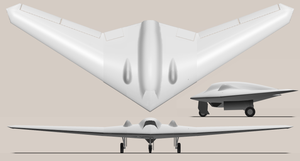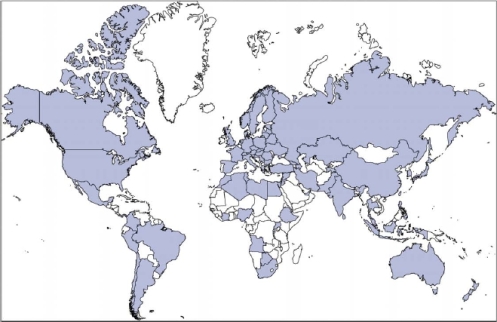

| Visitors Now: | |
| Total Visits: | |
| Total Stories: |

| Story Views | |
| Now: | |
| Last Hour: | |
| Last 24 Hours: | |
| Total: | |
Mapping Drone Proliferation: UAVs in 76 Countries

A new US Congress report on the proliferation of drones has confirmed a huge rise in the number of countries that
now have military unmanned aerial systems. The US Government Accountability Office (GAO) has published an
unclassified version of its February 2012 report on the proliferation of UAVs. The report examines both the proliferation
of UAVs, commonly known as drones, and examines US and multilateral controls on the export of drone technology.
The report states that between 2005 and December 2011, the number of countries that posses drones rose from
41 to 76 (see here for full list).
(Countries that have drones according to GAO report)
According to the report:
“The majority of foreign UAVs that countries have acquired fall within the tactical category. Tactical UAVs
primarily conduct intelligence, surveillance, and reconnaissance missions and typically have a limited
operational range of at most 300 kilometres. However, some more advanced varieties are capable of
performing intelligence collection, targeting, or attack missions. Mini UAVs were also frequently acquired
across the globe during this period.”
It should be noted that currently only the US, UK and Israel are known to have used armed UAVs.
The report goes on: “Currently, there are over 50 countries developing more than 900 different UAV systems.
This growth is attributed to countries seeing the success of the United States with UAVs in Iraq and Afghanistan and
deciding to invest resources into UAV development to compete economically and militarily in this emerging area.”
While the report fails to highlight the danger of growing drone proliferation to global peace and security it does
emphasize the danger of drone proliferation to “US interests”. The report states that “the use of UAVs by foreign parties
to gather information on U.S. military activities has already taken place” and “the significant growth in the number of
countries that have acquired UAVs, including key countries of concern, has increased the threat to the United States.”
Despite this, the report states “the U.S. government has determined that selected transfers of UAV technology support its
national security interests”, thus highlighting the contradiction at the heart of current arms control measures. ‘Private
sector representatives’ told the reports authors that “UAVs are one of the most important growth sectors in the defense
industry and provide significant opportunities for economic benefits if U.S. companies can remain competitive in the
global UAV market.”
Table 1: US drone sales Fiscal Year 2005-2010
The report reveals that between 2005 – 2010, the US approved over $380m of drone exports (Table 1). In total, the U.S.
government approved transfers of complete UAV systems in 15 cases over the period. Eight of the 15 countries were
names in the report: Denmark, Italy, Lithuania, United Kingdom, Australia, Colombia, Israel, and Singapore.
Additionally, 1,278 UAV-related licenses were identified over the period.
The US and the MTCR
The main international agreement that controls the transfer of drones is the Missile Technology Control Regime (MTCR).
Although not primarily focused on drones, the MTCR controls UAVs by dividing them into two categories. Category One
systems are capable of delivering a 500 kilogram warhead further than 300 kilometres, while Category II covers systems
that carry a lighter warhead or have a range of less than 300km. Although all decisions are taken on a national basis (and
there is no sanction by other countries if the MTCR is broken) there is a “strong presumption of denial” underpinning
Category One – that is, an assumption that MTCR signatory states will not export such systems. Countries have
greater discretion about exporting Category Two systems.
Drone Wars UK has previously highlighted efforts by US corporation to “relax” controls on the export of drones. However
the GAO report details for the first time “six US-sponsored UAV-related proposals” to amend the MTCR over the 2005-2011
period, five of which “would have resulted in moving some UAVs currently categorized under MTCR Category I to
Category II” and thus making them more easier to export. The five proposals were rejected by other members of the MTCR.
While the GAO report goes on to detail the need to improve internal US controls on the export of drones and related
technology (recommending improving information databases and communication between licensing departments and
intelligence agencies), it shies away from advocating the need to improve international controls.
Two weeks ago it was reported that the Pentagon has identified 66 countries that would be eligible to buy US drones
under new guidelines yet to be approved by Congress. Meanwhile, Germany wants to buy armed
drones; while neighbouring Poland plans to scrap its manned fighters for armed drones, just as Canada wants to
spend $1 billion on armed drones and Australia too plans to spend $3 billion on drones.
The time for global controls to stop the spread of drones has never been more urgent or important. Next month the
26th annual plenary meeting of the MTCR takes place in Berlin behind closed doors. No public agenda or details of
the meeting are available. We urge all those involved to see the growing dangers of drone proliferation and to resist the
siren calls by those with vested interests to relax the controls that currently exist.
Table 2: List of Countries reported by US GAO to posses drones.
| Algeria | Egypt | Lebanon | Singapore |
| Angola | Estonia | Libya | Slovakia |
| Argentina | Ethiopia | Lithuania | Slovenia |
| Australia | Finland | Malaysia | South Africa |
| Austria | France | Mexico | Spain |
| Azerbaijan | Georgia | Morocco | Sri Lanaka |
| Belarus | Germany | Netherlands | Sweden |
| Belgium | Greece | New Zealand | Switzerland |
| Botswana | Hungary | Nigeria | Syria |
| Brazil | India | Norway | Taiwan |
| Bulgaria | Indonesia | Pakistan | Thailand |
| Burundi | Iran | Panama | Trinidad & Tobago |
| Canada | Israel | Peru | Tunisia |
| Chile | Italy | Philippines | Turkey |
| China | Ivory Coast | Poland | Uganda |
| Colombia | Japan | Republic of Korea | Ukraine |
| Croatia | Jordan | Romania | UAE |
| Czech Republic | Kazakhstan | Russia | United Kingdom |
| Denmark | Latvia | Serbia |
United States *Republished under site guidelines from
|




